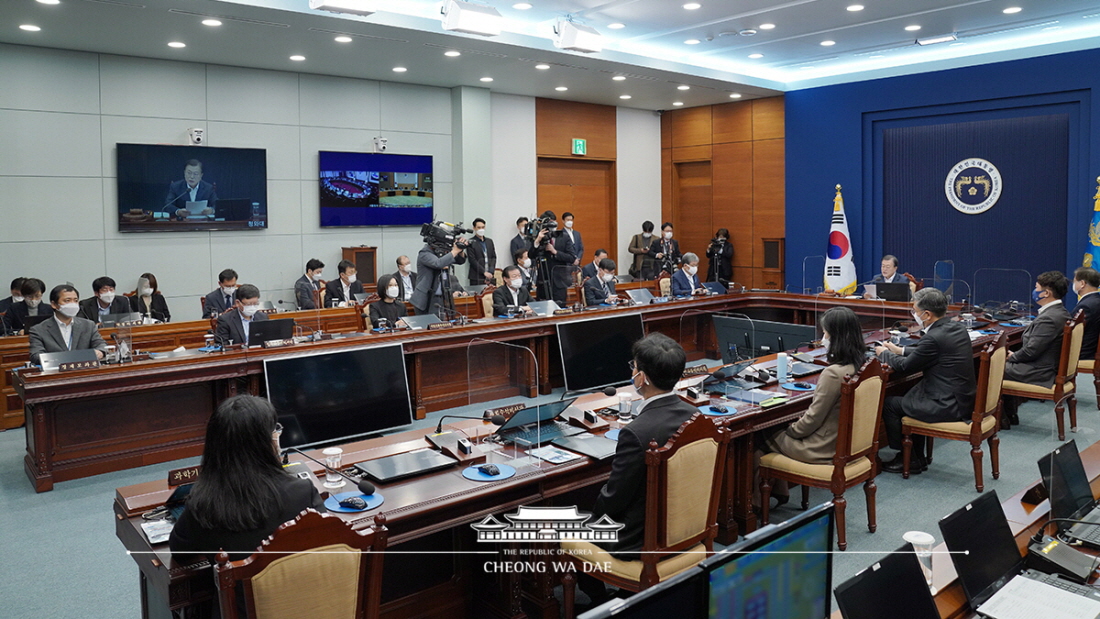이 웹사이트는 제19대 대통령 임기 종료에 따라 대통령기록관이 「대통령기록물 관리에 관한 법률」에 의해 이관받아 서비스하는 대통령기록물입니다. 자료의 열람만 가능하며 수정 · 추가 · 삭제는 불가능합니다.
다만, 「개인정보보호법」에 의하여 개인의 정보를 보호받기 원하시는 분은 관련 내용(요청자, 요청내용, 연락처, 글위치)을 대통령 웹기록물 담당자(044-211-2253)에게 요청해 주시면 신속히 검토하여 조치해 드리겠습니다. 감사합니다.
SPEECHES & REMARKS
BRIEFINGS

Let me begin the 57th Cabinet Meeting.
Last week, we marked the 50th anniversary of the death of martyred labor activist Chun Tae-il and revisited the importance of respecting labor. We have taken one step at a time toward a society that respects labor through progress in the labor movement and social agreements. However, it is truly regrettable that laborers are still continuing to lose their precious lives in industrial accidents.
My Administration has set a goal of halving the number of deaths linked to industrial accidents and made multifaceted efforts. We have improved substandard working conditions that threaten workers’ safety and strengthened supervision and oversight regarding industrial safety. The first overhaul of the Occupational Safety and Health Act in 30 years – dubbed the “Kim Yong-gyun Law” – expands the scope of protections, formulates an institutional framework to prevent dangerous work from being outsourced and hold those companies that hire contractors more accountable.
Such endeavors have helped gradually reduce the total number of deaths from industrial accidents, but the pace has not kept up with expectations. This is because the number of deaths at construction sites, which account for half of all industrial accident fatalities, has scarcely declined.
Approximately 60 percent of deaths from construction site accidents are caused by falls. These deaths are attributed to noncompliance with safety rules – poorly built scaffolds, the lack of safety equipment and not wearing personal protective gear. Being typical of accidents common in less-developed countries, they manifest the current state of our industrial safety, indeed, much to our shame.
About 75 percent of construction-related accidental falls occur at small and medium-sized sites. This is because, relative to large-scale construction sites, safety supervision is neglected and investment in safety equipment is insufficient. Following its launch, my Administration has increased the number of industrial safety supervisors by nearly 300 to strengthen supervision at small and medium-sized construction sites susceptible to fatal accidents, especially those with a high risk of death from falls. In cooperation with local governments, we have introduced unannounced, on-site inspections and deployed construction safety monitors to conduct regular inspections and preventative activities. At small construction sites, financial support for safety equipment installation and other measures has been greatly increased.
Despite all these efforts, we see no marked improvement in the reduction of fatal industrial accidents. This is because there is still considerable understaffing of supervisory personnel compared to the number of construction sites needing supervision and because most inspections end up being one-off events.
Where there’s a problem, there’s a solution. At this time, I urge the Government to forge a strong determination to dramatically curtail fatal construction site accidents. If necessary, the number of industrial safety supervisors must be further increased, and organizations must be set up to exclusively and closely oversee safety compliance at small and medium-sized construction sites. Regarding work at dangerous heights and other worksites with a high risk of falls, I urge you to make it mandatory to file advance reports and establish a regular on-site inspection system in cooperation with local governments. We should not spare any necessary support, including funding and human resources. A few years of intensive efforts will help a culture that values safety take root.
Nothing is more important than life. I ask you to keep in mind that a society where labor is respected starts with protecting a laborer’s right to work safely. Now is the time for Korea to cast off the disgrace of being ranked high among the OECD member states in terms of industrial accident fatalities.
Today, the Government decided to raise social distancing to Level 1.5 in the Seoul metropolitan area, beginning November 19. In Gangwon-do Province, local governments there will determine whether to follow suit. The measure is being taken after reflecting experts’ opinions as the number of new confirmed COVID-19 cases continues to climb and asymptomatic transmission keeps spreading in daily lives. In line with the adjusted social distancing level, the number of visitors to various facilities will be limited with every other seat left unoccupied, and other restraints will unavoidably be placed on daily routines and economic activities – although this does not mean closing the relevant facilities or suspending operations. I ask the people to understand that – though somewhat inconvenient – these measures cannot be avoided if we want to prevent the virus from spreading and bringing further damage. I call for active cooperation from everyone.
The Government will become even more vigilant and implement stricter epidemic prevention and control measures. We will do everything possible to safely hold the nationwide College Scholastic Ability test in 16 days, for example, by designating a special epidemic prevention and control period to strengthen relevant measures. I call on the people to come together with a single goal in mind so that the social distancing level can be lowered at the earliest date possible rather than being raised further.



